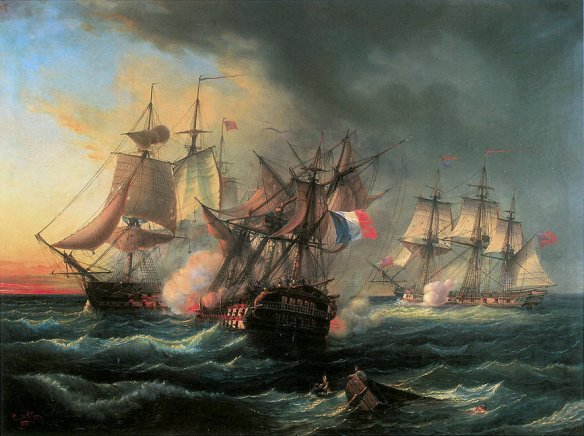Battle between the French warship Droits de l’Homme and the frigates HMS Amazon and Indefatigable, 13 & 14 January 1797, Leopold Le Guen.
In Dec 1796 the French attempted to land Hoche’s army in Ireland, loaded on the Brest Fleet 17 sol, 12 frigates, 13 other transports under the command of V. Adm Morard de Galles. Storms scatter the fleet, and the frigate carrying de Galles and Hoche is separated from the fleet and never arrives in Ireland, at Bantry Bay contra winds prevent landing any troops and the fleet eventually return to France. Capt Edward Pelley in HMS Indefatigable 44, (a razze 64 gun sol) is on blockade duty off Brest and harasses the French. On the return voyage Indefatigable and Amazon 38 attack Droits de l’Homme 74 in a storm, the storm prevents the 74 from using her lower guns and nearly sinks her when the gun ports are opened. Fire from the British frigates disable the French ship and she runs aground and wrecked, Amazon also runs aground and the crew is captured, Indefatigable is able to escape the rocks.
#
In December 1796 a French force of over 13,000 troops and 17 battleships had appeared off Bantry Bay, although it had not landed. Ireland was on the verge of revolt and French intervention could easily tip the situation towards open rebellion. A much smaller force actually landed at Fishguard in Wales. It was quickly rounded up, but not before a run on the Bank of England had started. In October 1797, the Directory ordered the assembly of flat-bottomed boats in the Channel ports and an Army of England consisting of 45,000 men was gathered along the Atlantic coast. Rebellion finally erupted in Ireland in 1798 and in August French forces about 1,150 strong landed at Killkila Bay. It, too, was quickly contained, but the rebellion went on much longer. Attempts to reinforce the French forces in Ireland were intercepted, but the French had shown an unnerving willingness to take great risks to get ashore on the British Isles. The plan to invade England had been abandoned in February 1798, but the overt threat of the invasion flotilla was kept up by the Consulate (1799–1804) until peace was signed in 1802.
